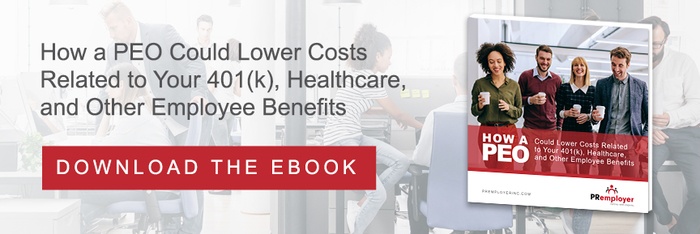
Many people are unfamiliar with the idea of the Professional Employer Organization. We like to be helpful so we set out a few common questions and answers about PEOs.
What is a PEO?
A Professional Employer Organization (PEO) is a company to whom small businesses outsource their human resource management and administrative responsibilities. The PEO acts as the employer of record for payroll and tax purposes which gives companies access to health and benefits plans negotiated at scale by the PEO.
What are the benefits of a PEO?
The primary benefits of contracting with a PEO come in the following areas:
-
Human Resource Administration - The PEO offers guidance with regard to regulatory compliance, employee discipline, conflict resolution, and employee relations.
-
Time and Attendance - Many PEOs help small businesses convert their business data into valuable, real-time information.
-
Payroll - PEOs provide payroll administration services, file tax reports, employee portals for employee benefits, onboarding new employees, and retaining company reports.
-
Workers' Compensation - PEOs guide companies through workers’ comp claims administration, training programs, employee background checks, and drug testing. When employees feel safe and work safe, their productivity rates climb which means the small businesses' profitability increases. According to economists Laurie Bassi and Dan McMurrer, businesses that use PEOs grow 7-9% faster than those who do not use them. Turnover is 23-32% lower and the businesses are 50% less likely to go out of business.
-
Risk Management - PEOs identify workplace hazards, help build safer workplaces, and help clients comply with all OSHA regulations.
-
Employee Benefits - While only 27% of small businesses provide retirement plans to their employees (according to the National Federation of Small Businesses (NFIB)), 95% of the members of the National Association of Professional Employer Organizations (NAPEO) offer their small business employees a retirement plan, often with a matching employer contribution.
-
Employee Recruitment - Many PEOs can help small businesses identify and hire the most talented people. Outsourced recruitment professionals save time and money in the recruitment process and prevent costly hiring mistakes.
What is a co-employment agreement?
A co-employment agreement is a written contract between the PEO and a small business client that allots specified employer responsibilities between them.
Once the PEO and employer sign the agreement, a co-employer relationship exists among the PEO, the employee, and the PEO's client. The PEO usually pays payroll and withholding with respect to each employee, submits employment reports, and collects and pays the client's taxes. The client retains responsibility for product development, management, marketing, sales, service, and all other business operations.
Does a co-employment agreement mean business owners give up some control over their business?
The answer is a resounding no. The client-employer retains control over the day-to-day business operations including setting pay rates, making final hiring decisions, adopting discipline policies, and managing employees' performances.
The PEO provides support and training in specified areas so the client-employer can concentrate on what it does best: growing the company.
Why do PEOs use co-employment agreements?
The co-employment agreement makes the PEO the employer of record solely for the purposes of payroll and taxes. This role is what gives PEOs the authority to negotiate master health and benefit plans on behalf of the client's employees.
What do employees think about PEOs?
According to a recent study, 8% more employees working under a PEO say their employer shows its commitment to them. Employees working under a PEO arrangement are 8% more likely than non-PEO employees to say their employer has good hiring practices. They are 5% more likely than non-PEO workers to say that the employer has good HR practices. In addition, they are 4% more likely than non-PEO employees to say that the employer designs employee jobs well and provides superior training.
How can PEOs increase profitability without knowing their client's industry?
Clients see increased profits because they are free to concentrate on growing their businesses instead of being burdened by administrative tasks and compliance regulations. This means employees increase their productivity.
A 2012 study by Towers Watson found a correlation between employee productivity and corporate profits. Profit margins of companies with highly engaged employees were three times higher than those with employees with low engagement scores. The reason is that highly engaged employees lead to increased productivity, lower absenteeism, lower turnover, and lower healthcare costs. Engaged employees also reported a 65% greater ability to stay productive throughout the day.
How can PEOs have an average ROI of 27.2%?
Cost savings are the key to return on investment (ROI) calculations. The 27.2% average ROI for PEO clients is based on cost savings PEO clients accumulate in five business areas:
-
Human Resources (in Reduced Personnel Costs)
-
Health Benefits
-
Workers' Compensation
-
Unemployment Insurance
-
Other outlays related to payroll, benefits, etc.
The greatest cost savings come from the human resources area. The net cost savings of a PEO client are the savings the client receives from hiring a PEO minus the cost of hiring the PEO. Dividing the net cost savings by the cost yields the ROI. In this example, half of the PEO clients in the study's database would have a higher than 27.2% ROI and the other half would experience a lower than 27.2% ROI.
Do business owners have the option of retaining their current healthcare broker?
The answer to this question depends on the PEO. Some organizations will only agree to undertake all roles, including the role of healthcare broker. However, PEOs that are best in class provide flexibility to meet the client's provider preferences.
How are PEOs priced?
PEO pricing schemes basically come in two varieties: bundled and unbundled. Bundled quotes mean one fixed price for every payroll delivered to the client. Bundled fees usually quote dollars for every $100 of payroll.
Unbundled quotes do not contain one single fixed fee. PEOs using unbundled quotes set fees after breaking them down into several categories, with specific pricing for each category such as:
-
"pass-through" costs like FICA, FUTA, and Medicare;
-
Workers' Compensation;
-
State Unemployment Compensation;
-
Administrative Fees.
To lean more about how PEOs can help your company, please contact us. We will be happy to help you grow your business.

